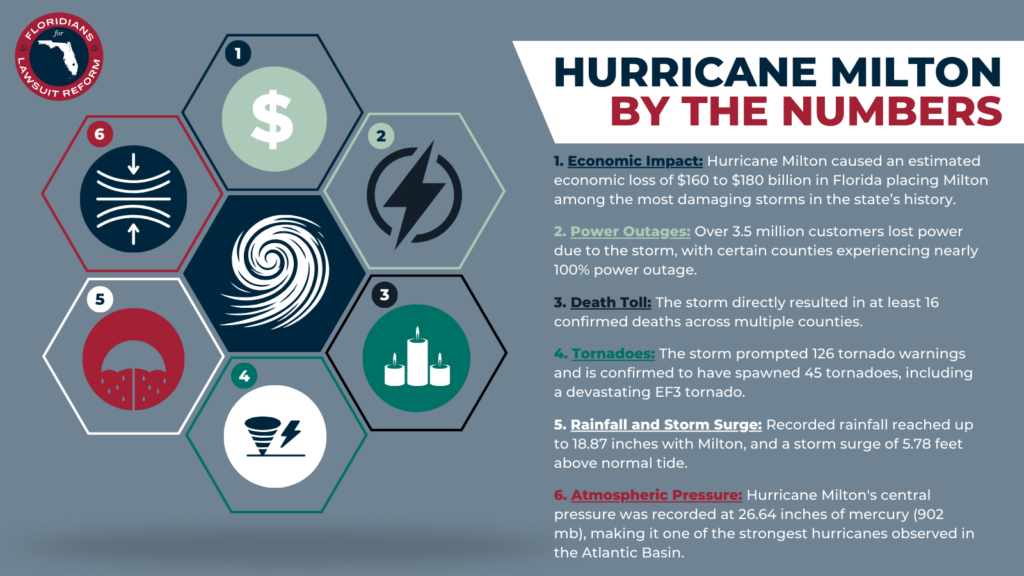
Published Oct 10, 2024 4:07 PM EDT | Updated Oct 11, 2024 12:38 PM EDT
Hurricane Milton set several meteorological records this week, and brought extreme rainfall, surge and wind gusts with it. Here’s a look at the numbers.
Hurricane Milton made landfall near Siesta Key, Florida, at 8:30 p.m. EDT Wednesday. The storm has knocked out power to millions of people in Florida and has caused at least 10 deaths. As residents pick up the pieces, these are some of the astounding numbers associated with the destructive storm.
$160-180 billion
AccuWeather preliminarily estimates the total damage and economic loss from historic Hurricane Milton will be between $160 billion and $180 billion. Milton will go down as one of the most damaging and impactful storms in Florida history, along with Hurricane Helene’s estimated total damage and economic loss of $225-250 billion just two weeks ago, which resulted in significant damage from the Gulf Coast of Florida to the southern Appalachians, where a catastrophic flooding disaster occurred.
45 tornado reports, one EF3
National Weather Service offices in Florida issued 126 tornado warnings as Hurricane Milton approached. There were 45 tornadoes reported to the Storm Prediction Center. One tornado killed several people in St. Lucie on the east coast of Florida.
Another tornado near Palm Beach Gardens on the eastern shore of the state has been preliminarily rated EF3 by the NWS.
The record-holder for tornadoes spawned by a hurricane is 120 with Hurricane Ivan in 2004. In 2023, Hurricane Beryl spawned 68 twisters.
5th hurricane landfall
Hurricane Milton is the fifth hurricane to make landfall on the Gulf Coast this season, after Beryl, Debby, Francine and Helene. The 2005 and 2020 hurricane seasons also had five. Only the year 1886 had more, with six hurricanes making landfall in the Gulf that season. For continental U.S., having five landfalling hurricanes ranks third for number of strikes.
Milton is the third hurricane to hit the state of Florida this year. No other year on record has more than three. After an early pause, the 2024 Atlantic hurricane season is now above normal by all measures.
3,539,158 customers
Although most customers in Florida who lost power from Helene were restored before Milton approached, 100,000 customers had lost power in Florida because of the new storm by Wednesday morning. As Hurricane Milton got closer to the coast, numbers spiked, and 2.5 million had lost power by midnight. Outages were still going up Thursday morning, eclipsing 3.5 million. Hardee and Highlands counties reported that nearly 100% of customers were in the dark.
16 deaths
In the wake of Hurricane Milton, the death toll has risen to at least 16people. St. Lucie County on Florida’s Atlantic coast first confirmed five deaths, attributed to tornadoes that touched down during the storm, WPBF News reported. In St. Petersburg, police confirmed two storm-related deaths. Volusia County has also reported fatalities, with Sheriff Michael J. Chitwood confirming that three people died in his jurisdiction.
16.67 inches of rain
At the St. Petersburg Albert Whitted Airport, 18.87 inches of rain fell during Hurricane Milton. In just one hour, the rain gauge recorded 5.09 inches, an extremely rare rainfall rate. As Milton moved across Florida, an AccuWeather/Ambient Weather rain gauge recorded 16.67 inches at Lakeland, 32 miles northeast of Tampa.
+5.78 storm surge
The storm surge at Naples, Florida, reached 5.78 feet above normal tide, nearly a foot higher than Hurricane Helene on Sept. 26 and almost 3 feet above Hurricane Debby on Aug. 4.
At Fort Myers, the gauge rose to 5.26 feet, slightly above the crest reached during Hurricane Helene at 5.12, but short of the 50-year record set by Hurricane Ian of 7.26 feet on Sept. 28, 2022.
-4.85 feet blowout
Instead of the water rising in Tampa Bay, a tidal gauge downtown, just north of the storm’s landfall where winds were from the land, experienced a “blowout tide” or anti-storm surge. This happens when high winds from a tropical storm or hurricane blow from the land instead of the ocean, temporarily pushing water in bays out to sea. The water level fell to nearly 5 feet below normal as winds blew water in the bay out into the Atlantic Ocean.
105-mph wind gust
The strongest wind gust reported during the storm was 105 mph at a WeatherFlow weather station in the Egmont Channel, southwest of St. Petersburg. The Bradenton and St. Petersburg airports also gusted to 102 and 101 mph, respectively.
26.64 inches of mercury
Hurricane Milton’s central pressure fell to 26.64 inches of mercury (902 mb) on Oct. 8, making it the fifth-strongest hurricane ever observed in the Atlantic Basin and the second-lowest for this late in the year. Milton’s sustained winds were estimated at 180 mph, and only five Atlantic hurricanes have had estimated winds higher than Milton’s.
2,000 gas stations
As of the morning of October 11, about a quarter of gas stations – around 2,000 – across Florida didn’t have fuel, according to gas price-tracking platform GasBuddy. In harder hit areas, these numbers were higher: nearly two-thirds of the gas stations in the Tampa and St. Petersburg area had no fuel as of 10:30 a.m. and 44% in Sarasota were dry on October 11.
